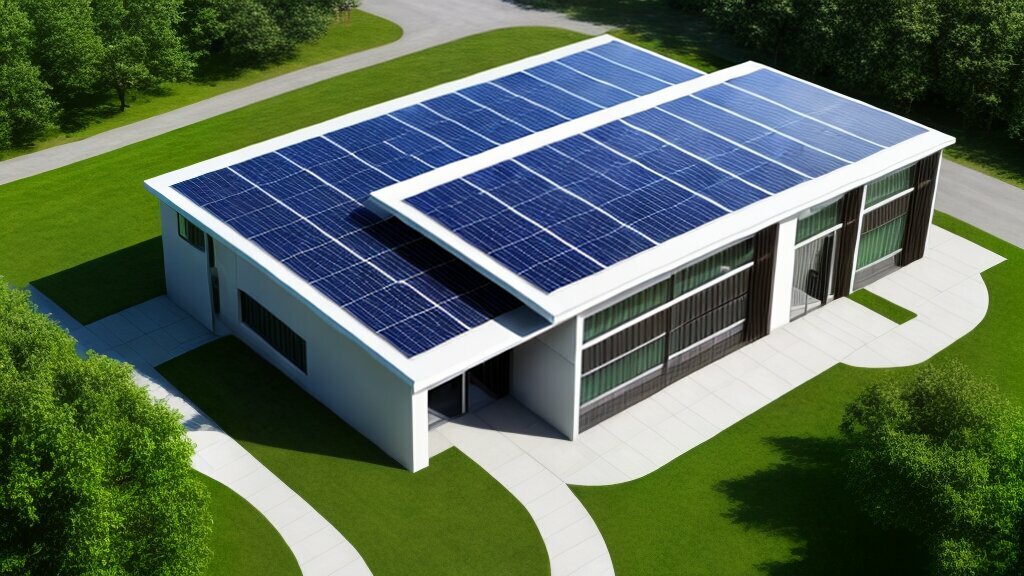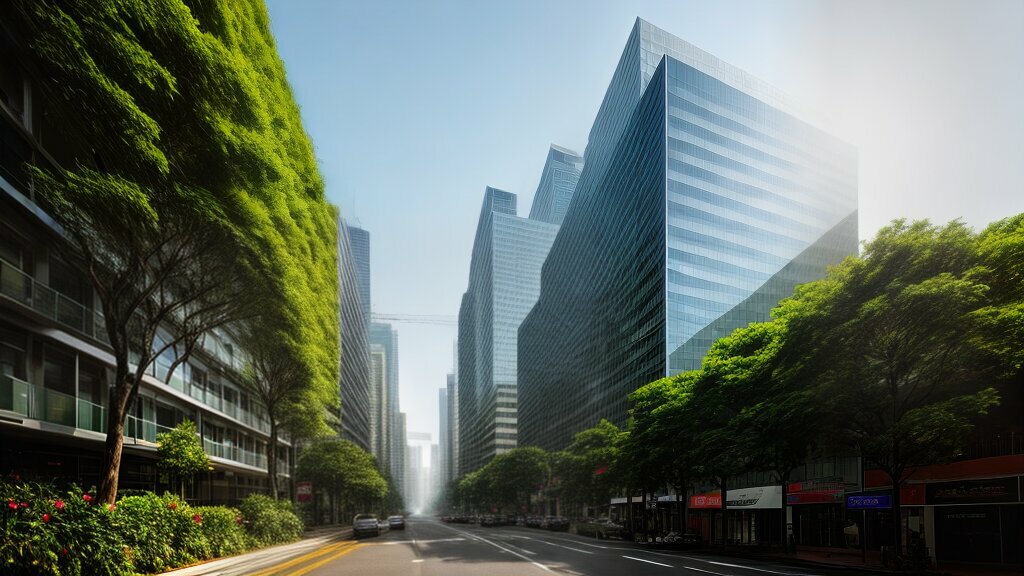Welcome to the world of Net-Zero Energy Buildings: Design Principles and Case Studies. In today’s world, buildings contribute to around 40% of global energy consumption. The demand for sustainable buildings has increased, and net-zero energy buildings offer the perfect solution. These buildings are designed to reduce energy consumption and promote sustainable architecture by generating the same amount of energy they consume.
Net-zero energy buildings are the future of sustainable architecture, and it’s important to design energy-efficient buildings. This section will discuss the design principles and case studies that demonstrate the success of these buildings in reducing energy consumption and promoting sustainable architecture.
Key Takeaways:
- Net-zero energy buildings generate the same amount of energy they consume.
- These buildings are designed to reduce energy consumption and promote sustainable architecture.
- Design principles and case studies showcase the success of net-zero energy buildings.
Sustainable Building Design
Sustainable architecture is an innovative approach to building design that promotes environmental responsibility and energy efficiency. It emphasises the use of eco-friendly materials and renewable energy sources in construction projects.
Green building design incorporates a range of techniques and strategies to create energy-efficient buildings that minimise their carbon footprint. This includes using materials with high thermal mass to regulate temperature, designing buildings to maximise natural light, and integrating renewable energy sources such as solar panels and wind turbines.
| Techniques and Strategies: |
Materials with high thermal mass |
Maximising natural light |
Renewable energy sources |
| Benefits: |
Reduced carbon footprint |
Lower energy costs |
Healthier indoor environments |
Renewable energy integration is a key aspect of sustainable building design. By generating clean energy on-site, buildings can reduce their reliance on traditional energy sources and decrease their carbon emissions. The integration of solar panels and wind turbines in building designs is becoming increasingly common, as these technologies have become more cost-effective and efficient.
Sustainable building design also involves the use of sustainable building materials, such as recycled steel and bamboo. These materials have a lower environmental impact than traditional building materials, and contribute to energy efficiency in construction projects. By using sustainable building materials, we can reduce waste and preserve our natural resources.
Overall, sustainable building design is essential for promoting energy efficiency and environmental responsibility in the construction industry. By incorporating renewable energy sources and sustainable building practices into our designs, we can create a more sustainable future for ourselves and for generations to come.
 Sustainable building design incorporates renewable energy sources and eco-friendly materials to create energy-efficient buildings.
Sustainable building design incorporates renewable energy sources and eco-friendly materials to create energy-efficient buildings.
Case Studies of Net-Zero Energy Buildings
Real-life examples of net-zero energy buildings demonstrate how sustainable construction techniques and innovative design principles can lead to zero-carbon emissions. These buildings serve as a source of inspiration for future architects and developers striving to create energy-efficient buildings.
One such example is the Bullitt Center in Seattle, Washington. Completed in 2013, the Bullitt Center is a six-story, 50,000 square-foot commercial building that produces as much energy as it uses. The building features solar panels, natural ventilation, and geothermal heating and cooling systems. It also incorporates sustainable building materials, such as FSC-certified wood and salvaged materials.
| Building Name |
Location |
Completion Date |
| The Edge |
Amsterdam, Netherlands |
2014 |
| Yale Health Center |
New Haven, Connecticut |
2010 |
| Research Support Facility |
Golden, Colorado |
2010 |
Another example is The Edge, a 430,000 square-foot office building in Amsterdam. Completed in 2014, The Edge is considered one of the most sustainable buildings in the world. It features a smart lighting system that adjusts to individual needs and preferences, a rooftop solar array, and rainwater collection systems.
The Yale Health Center in New Haven, Connecticut, completed in 2010, is another net-zero energy building. It features geothermal heating and cooling, solar panels, and energy-efficient lighting. The building also incorporates sustainable building materials, such as bamboo flooring and recycled steel.
The Research Support Facility in Golden, Colorado is a net-zero energy building that serves as the headquarters for the National Renewable Energy Laboratory. Completed in 2010, the facility features a large solar array, natural ventilation, and intelligent lighting systems. It also incorporates sustainable building materials, such as bamboo and recycled content carpet tiles.
These case studies demonstrate the potential for net-zero energy buildings and serve as a source of inspiration for architects, builders, and developers looking to promote sustainable architecture and design.

Energy Consumption Minimization
Minimizing energy consumption is a critical aspect of designing net-zero energy buildings. Using sustainable building materials and practices, while implementing energy-efficient technologies, are key strategies to achieve this goal.
| Sustainable building materials |
Benefits |
| Bamboo |
Fast-growing and renewable |
| Recycled steel |
Uses less energy and reduces waste |
| Rammed Earth |
Low embodied energy and high thermal mass |
Using sustainable building materials like bamboo, recycled steel, and rammed earth can help reduce the environmental impact of construction projects while promoting energy efficiency. These materials have lower embodied energy and are often locally sourced, reducing transportation costs and emissions.
In addition to using sustainable building materials, implementing sustainable building practices can also minimize energy consumption. Passive design techniques, such as optimizing building orientation and ventilation, can reduce the need for artificial heating and cooling. Incorporating daylighting into the building design can also reduce reliance on artificial lighting sources, leading to energy savings.

“Sustainable architecture is a pathway to net-zero energy buildings, promoting environmental responsibility and energy efficiency.”
By minimizing energy consumption through the use of sustainable building materials and practices, we can help promote a more eco-friendly construction industry and move towards a more sustainable future.
Importance of Renewable Energy Integration
Renewable energy integration is a crucial aspect of designing net-zero energy buildings. Utilizing solar, wind, and other renewable energy technologies to power buildings reduces reliance on traditional energy sources and minimizes carbon emissions, promoting a more sustainable urban environment.

Integrating renewable energy sources into building design requires a strategic approach to ensure optimal functionality and efficiency. This involves considerations such as the orientation of the building and positioning of solar panels, as well as the capacity of the energy storage system to ensure continuous power supply.
Through renewable energy integration, net-zero energy buildings can generate their energy, significantly reducing operating costs and providing a reliable source of power. Moreover, renewable energy technologies provide a long-term solution to energy supply, helping to future-proof buildings to withstand the impact of climate change.
However, the implementation of renewable energy technologies can be challenging and requires an integrated approach to building design and construction. This involves working closely with industry stakeholders to develop robust policies and regulations that promote the use of renewable energy and encourage sustainable building practices.
Role of Sustainable Building Materials
The use of sustainable building materials plays a crucial role in designing net-zero energy buildings. Eco-friendly materials not only have a lower environmental impact than traditional building materials, but they also contribute to energy efficiency in construction projects. By choosing sustainable building materials, architects and builders can reduce the carbon footprint of a building and promote a healthier living environment for its occupants.
Sustainable building materials can be sourced from a variety of renewable resources. Timber, for instance, is a popular choice for sustainable building due to its natural abundance and renewability. Moreover, timber is an effective insulator and can significantly reduce the energy consumption of a building.
Another sustainable building material is recycled steel. Recycled steel products can be used to construct building frames, roofs and other structural components. Steel is a durable material that can withstand a wide range of environmental conditions, making it an ideal choice for building design.
Additionally, eco-friendly insulation materials such as cellulose or recycled denim can provide an energy-efficient insulation solution for buildings. These materials are non-toxic, sustainable, and help to maintain a comfortable indoor temperature while reducing energy consumption.
Finally, building materials such as bamboo and rammed earth offer sustainable alternatives to traditional concrete and brick. Bamboo is a fast-growing and renewable source of building material that is highly durable and can be used in a variety of construction projects. Rammed earth, on the other hand, is a low-carbon alternative to concrete that is made by compressing soil and other natural aggregates into solid walls.

“The use of sustainable materials in construction is essential to creating a healthier and more sustainable future for our planet.”
By integrating sustainable building materials into the design of net-zero energy buildings, architects and builders can create buildings that are not only energy-efficient but also eco-friendly. With the availability of a wide range of sustainable building materials, designers have the flexibility to choose materials that match their design vision while contributing to a more sustainable future.
Sustainable Building Practices
Designing sustainable buildings requires careful consideration of various factors to promote energy efficiency and environmental responsibility. Sustainable building practices are a cornerstone of net-zero energy buildings, and they include strategies such as passive design, daylighting, and efficient HVAC systems.
Passive design involves maximizing natural light and heat gain while minimizing solar heat gain and heat loss. This technique can be achieved through careful orientation and layout, proper shading, and the use of materials with proper thermal insulation.
Daylighting is another crucial aspect of sustainable building design. It involves the use of natural light to reduce the need for artificial lighting, which can significantly lower energy consumption. By strategically positioning windows and skylights and using light-reflecting materials, building occupants can benefit from natural light while minimizing glare and heat gain.

Efficient HVAC systems are essential in net-zero energy buildings. This type of system optimizes heating, cooling, and ventilation while reducing energy consumption by using high-efficiency equipment and optimizing the entire system’s design. Additionally, the use of automated controls and sensors can improve HVAC system performance and reduce energy consumption by adjusting temperature settings and ventilation rates based on occupancy and environmental conditions.
Integrating sustainable building practices into construction projects offers numerous benefits, including reducing energy costs, improving indoor environmental quality, and reducing overall environmental impact. These practices also present several challenges, such as increased construction costs and the need for specialized expertise, but the long-term benefits and positive environmental impacts outweigh these challenges.
Benefits and Challenges of Net-Zero Energy Buildings
Net-zero energy buildings are a game-changer in the field of sustainable architecture, offering numerous benefits for both the environment and occupants. They significantly reduce the carbon footprint of buildings and promote a healthier indoor environment by reducing the use of fossil fuels and improving air quality. Additionally, they offer greater energy independence, as these buildings can generate their own power through renewable energy sources such as solar and wind.
However, achieving net-zero energy status can present some challenges. The initial cost of building a net-zero energy building can be higher than that of a traditional building, as it requires the use of specialised materials and technologies. Additionally, to maintain net-zero energy status, these buildings require a high level of maintenance and monitoring, which can require additional effort and expense.
Another challenge is the limited availability of skilled professionals and contractors who specialize in designing and constructing net-zero energy buildings. This lack of expertise can lead to design and construction errors that compromise energy efficiency and result in higher energy consumption.
Despite these challenges, the potential benefits of net-zero energy buildings are significant. By reducing reliance on traditional energy sources and promoting sustainable architecture, these buildings offer a positive impact on the environment and the wellbeing of occupants.

“Our responsibility is to create a sustainable future for our children, and net-zero energy buildings are a significant step towards achieving that goal.”
As the construction industry continues to evolve, the trend towards sustainable building practices and net-zero energy buildings is expected to grow. Although there are challenges, the potential environmental and societal benefits are compelling reasons to continue developing and promoting these innovative building designs.
Conclusion
Net-zero energy buildings are the way forward for sustainable architecture. They not only reduce our reliance on traditional energy sources but also benefit the environment and our well-being. The design principles and case studies presented in this article demonstrate the success of energy-efficient buildings in minimizing their carbon footprint.
However, the road to achieving net-zero energy buildings is not without its challenges. It requires a concerted effort from the construction industry to implement sustainable building practices and to integrate renewable energy sources into building design.
Despite the challenges, the benefits of net-zero energy buildings cannot be denied. By reducing our carbon footprint and promoting environmental responsibility, we can create a brighter and more sustainable future for generations to come.
FAQ
Q: What are net-zero energy buildings?
A: Net-zero energy buildings are buildings that generate as much energy as they consume, resulting in zero net energy consumption from the grid. These buildings are designed to be highly energy-efficient and often incorporate renewable energy sources to meet their energy needs.
Q: What are the design principles of sustainable architecture?
A: Sustainable architecture involves designing buildings that minimize their environmental impact. This includes integrating renewable energy sources, using sustainable building materials, and implementing energy-efficient practices such as passive design and efficient HVAC systems.
Q: Can you provide case studies of net-zero energy buildings?
A: Yes, we have several case studies of net-zero energy buildings that showcase innovative construction techniques and sustainable practices. These projects serve as examples of successful zero-carbon buildings that can inspire future building design.
Q: How can energy consumption be minimized in buildings?
A: Energy consumption in buildings can be minimized through various strategies. This includes using sustainable building materials that are energy-efficient, implementing sustainable construction practices, and adopting technologies and systems that reduce energy usage.
Q: Why is renewable energy integration important in building design?
A: Integrating renewable energy sources into building design is crucial for creating energy-efficient buildings that reduce reliance on traditional energy sources. Solar, wind, and other renewable technologies help power net-zero energy buildings and contribute to a sustainable construction industry.
Q: What role do sustainable building materials play in designing net-zero energy buildings?
A: Sustainable building materials play a vital role in designing net-zero energy buildings. These materials have a lower environmental impact, contribute to energy efficiency, and promote sustainable construction practices. They help create healthier and more environmentally friendly buildings.
Q: What are sustainable building practices?
A: Sustainable building practices are construction techniques that prioritize energy efficiency and environmental responsibility. These practices include passive design, daylighting, efficient HVAC systems, and other strategies that promote the creation of net-zero energy buildings.
Q: What are the benefits and challenges of net-zero energy buildings?
A: Net-zero energy buildings have numerous benefits, including reduced environmental impact, lower energy costs, and improved occupant well-being. However, implementing these designs may present challenges such as higher upfront costs and the need for specialized expertise in sustainable architecture.
You may also like:
Innovative Green Building Materials: Paving the Way for Sustainable Construction
Advancements in Solar Integration for Sustainable Building Energy Systems







 Sustainable building design incorporates renewable energy sources and eco-friendly materials to create energy-efficient buildings.
Sustainable building design incorporates renewable energy sources and eco-friendly materials to create energy-efficient buildings.
















Post comments (1)